Abstract
We have examined the regulation of protein turnover in rat skeletal myotubes from the L8 cell line. We measured protein synthesis by the rates of incorporation of radiolabelled tyrosine into protein in the presence of a flooding dose of non-radioactive tyrosine. We monitored degradation of proteins labelled with radioactive tyrosine by the release of acid-soluble radioactivity into medium containing excess nonradioactive tyrosine. Extracellular tyrosine pools and intracellular tyrosyl-tRNA equilibrate rapidly during measurements of protein synthesis, and very little reutilization of the radiolabelled tyrosine occurs during degradation measurements. Measured rates of protein synthesis and degradation are constant for several hours, and changes in myotube protein content can be accurately predicted by the measured rates of protein synthesis and degradation. Most of the myotube proteins labelled with radioactive tyrosine for 2 days are degraded, with half-lives (t1/2) of approx. 50 h. A small proportion (less than 2.5%) of the radiolabelled proteins are degraded more rapidly (t1/2 less than 10 h), and, at most, a small proportion (less than 15%) are degraded more slowly (t1/2 greater than 50 h). A variety of agents commonly added to primary muscle cell cultures or to myoblast cell lines (18% Medium 199, 1% chick-embryo extract, antibiotics and antifungal agents) had no effect on rates of protein synthesis or degradation. Horse serum, fetal bovine serum and insulin stimulate protein synthesis and inhibit the degradation of long-lived proteins without affecting the degradation of short-lived proteins. Insulin-like growth factors (IGF)-1 and -2 also stimulate protein synthesis and inhibit protein degradation. The stimulation of protein synthesis and the inhibition of protein degradation are of similar magnitude (a maximum of approx. 2-fold) and display similar sensitivities to a particular anabolic agent. Insulin stimulates protein synthesis and inhibits protein degradation only at supraphysiological doses, whereas IGF-1 and -2 are effective at physiological concentrations. These and other findings suggest that IGFs may be important regulators of skeletal muscle growth during the fetal and early neonatal periods.
Full text
PDF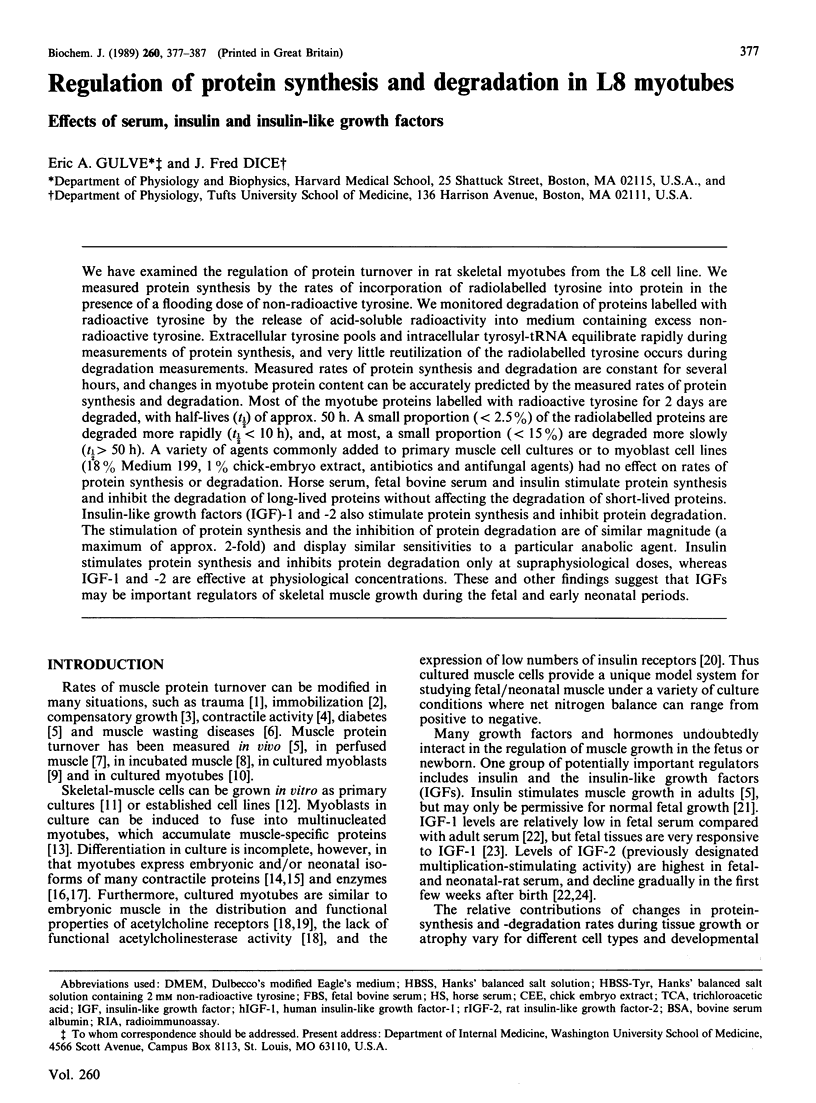
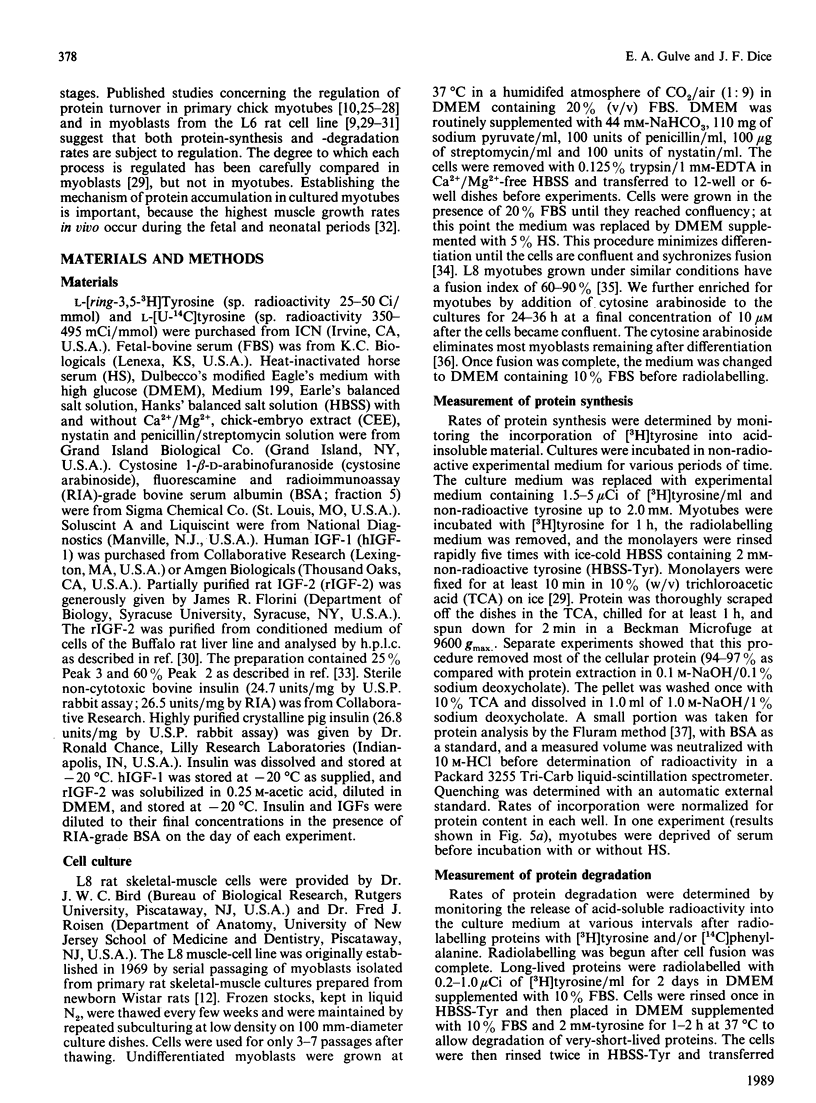
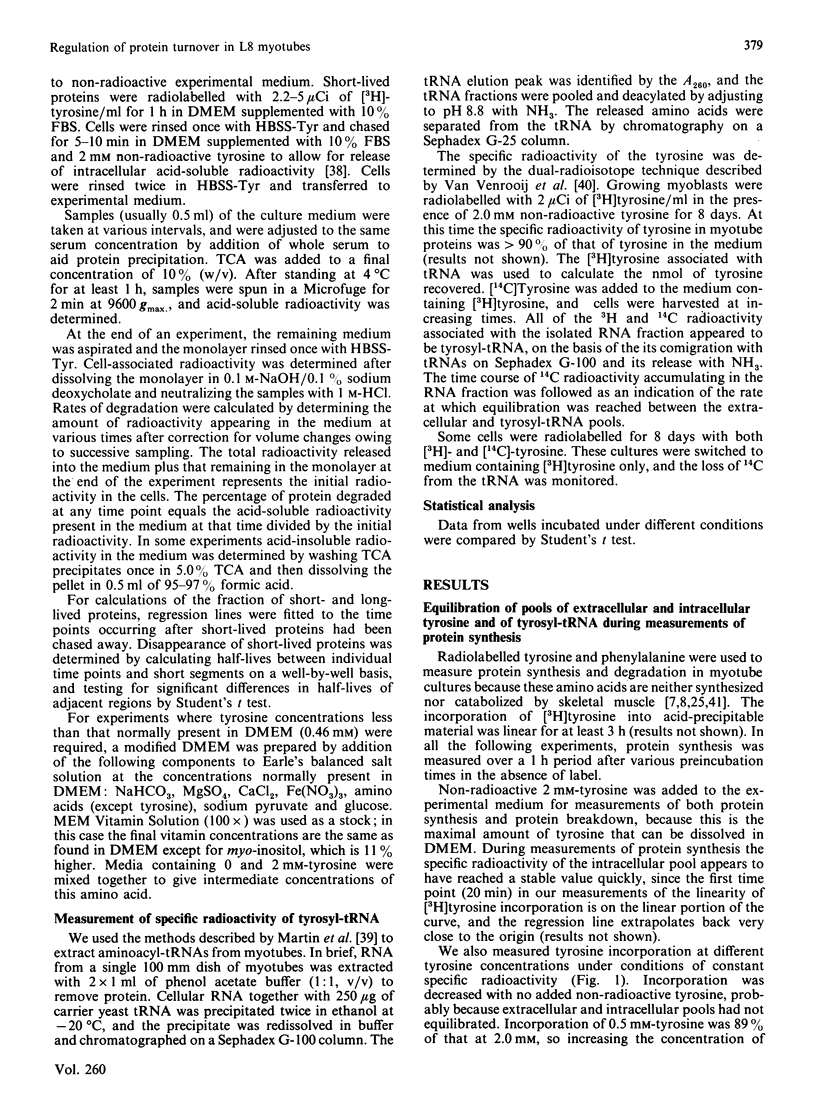
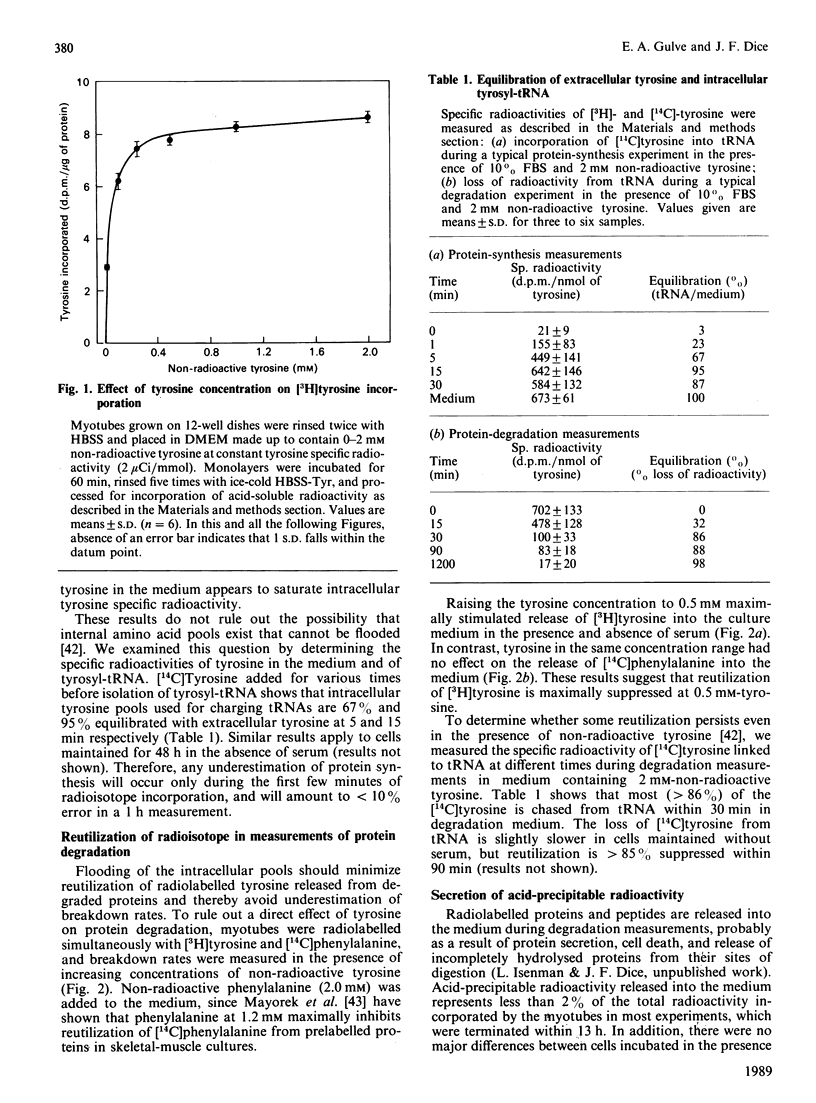
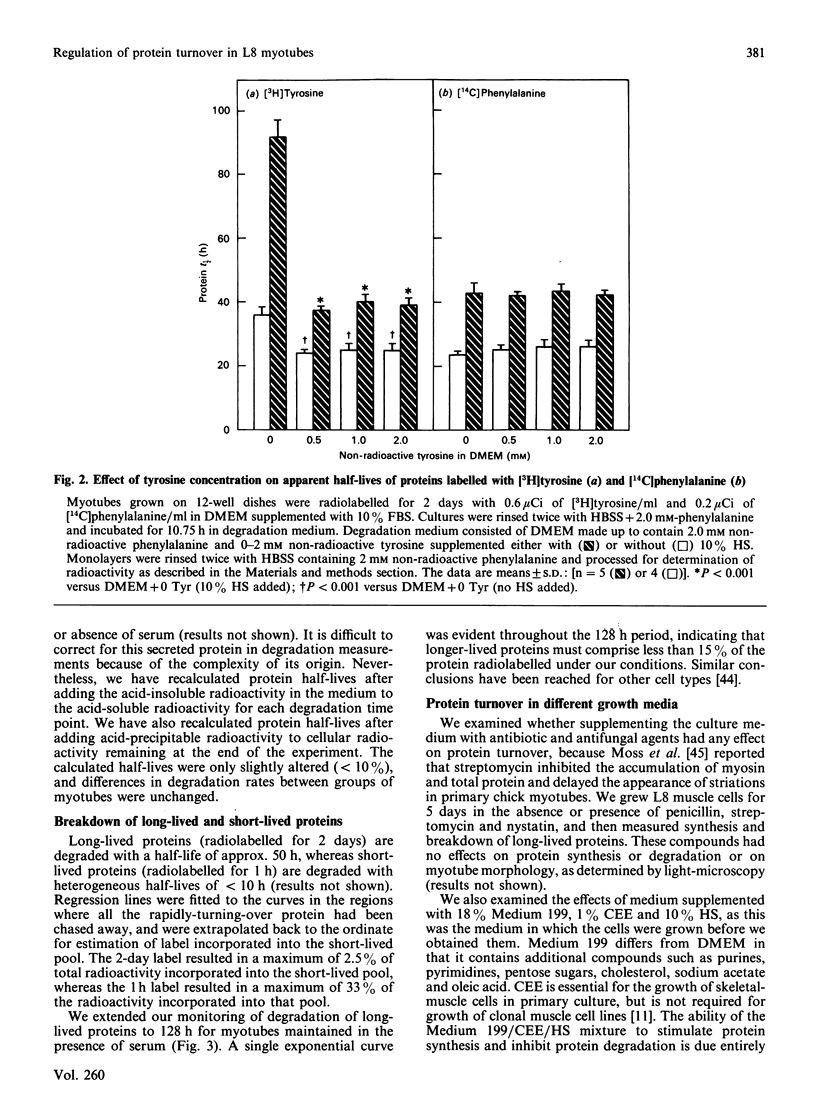

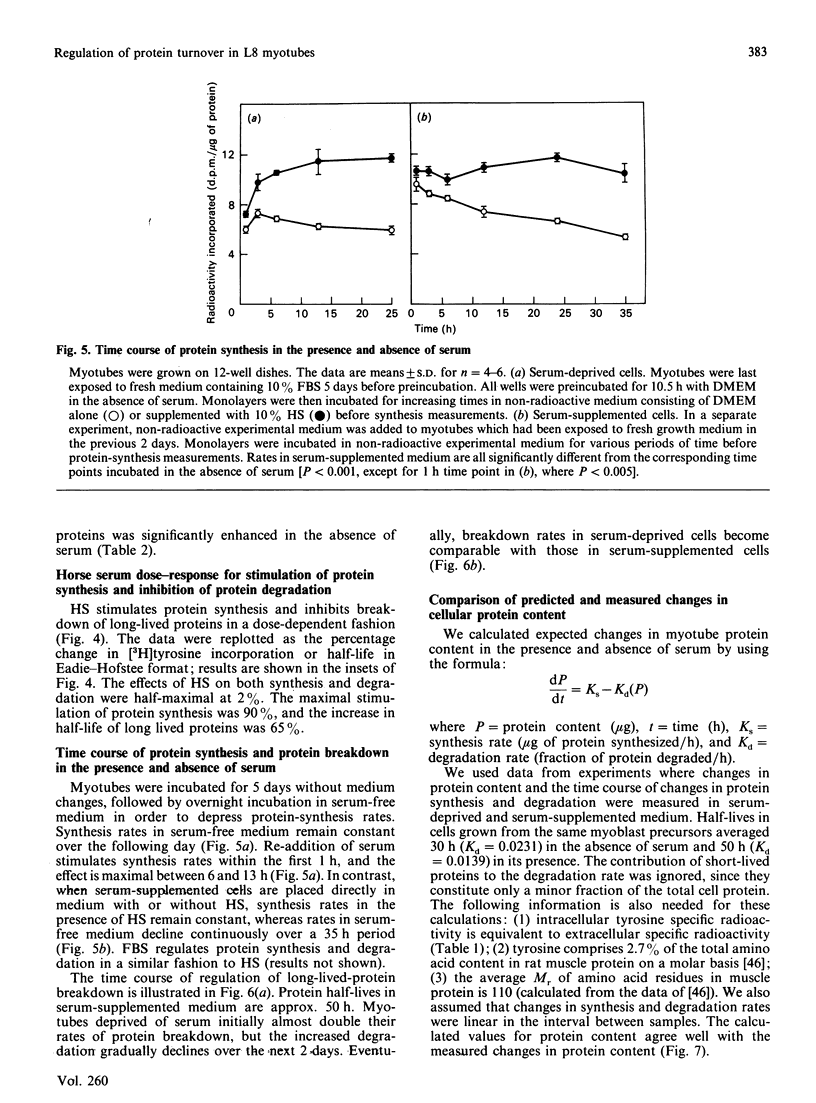
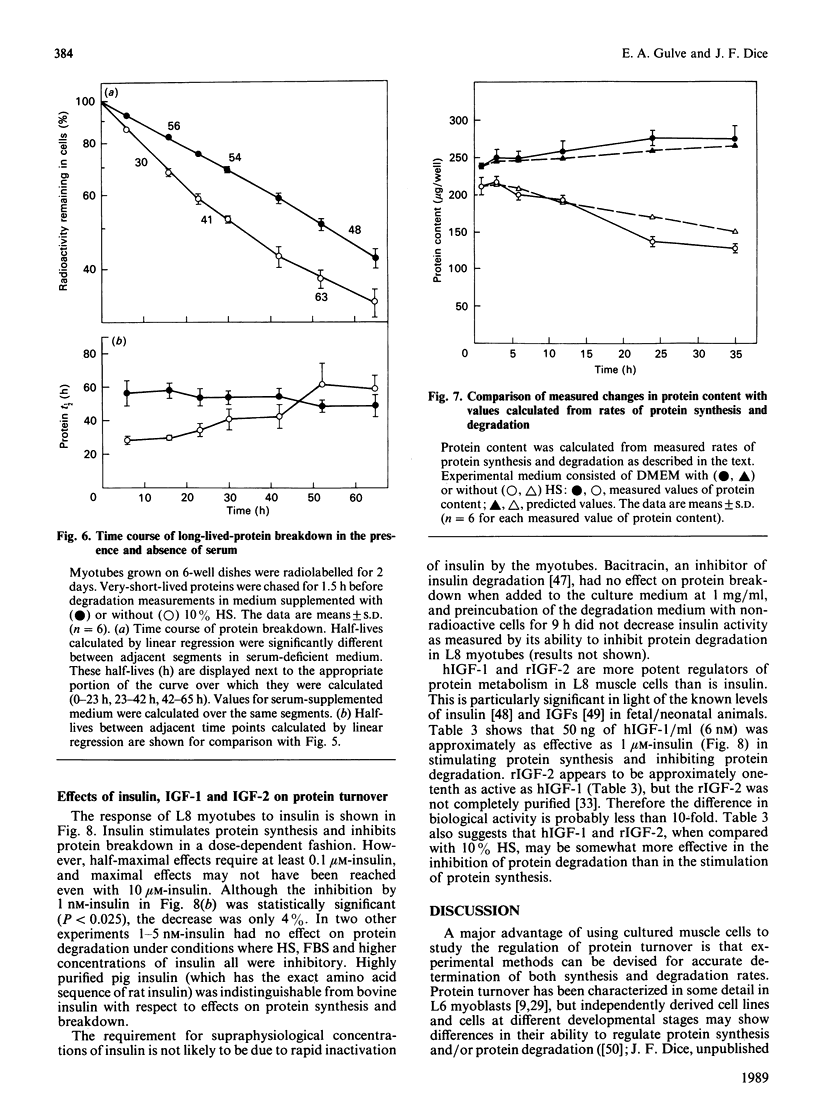
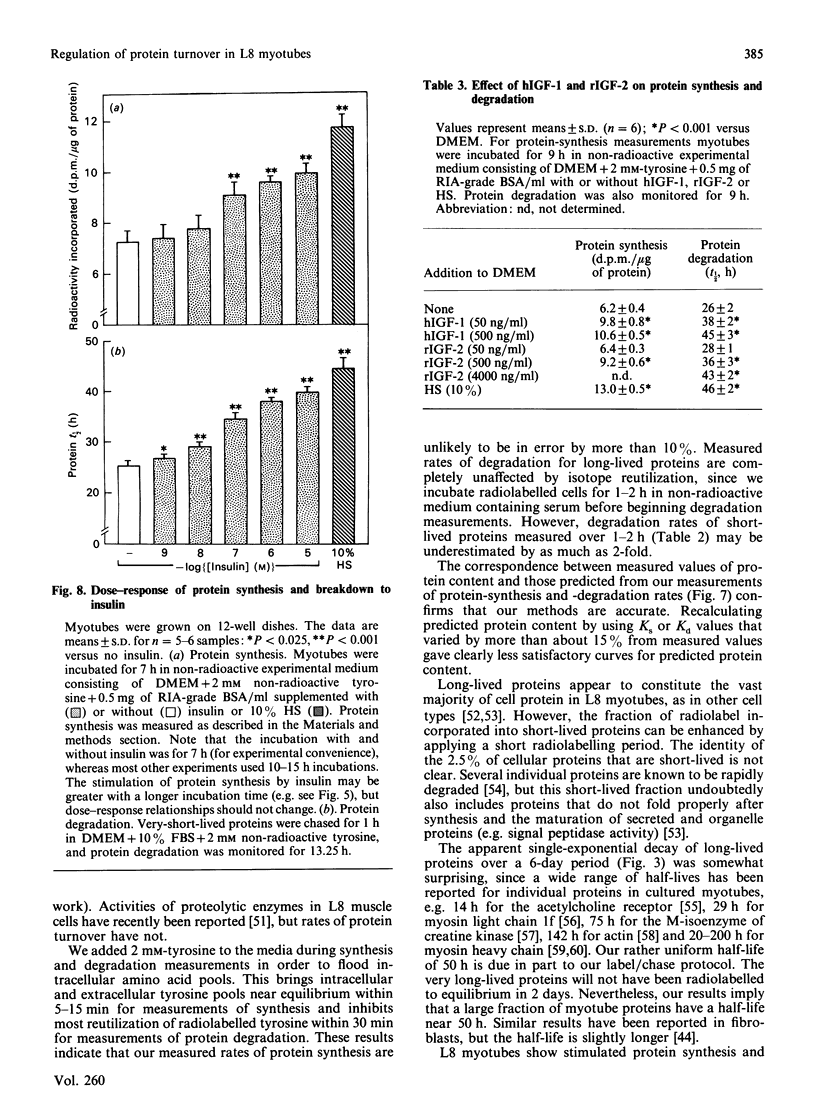
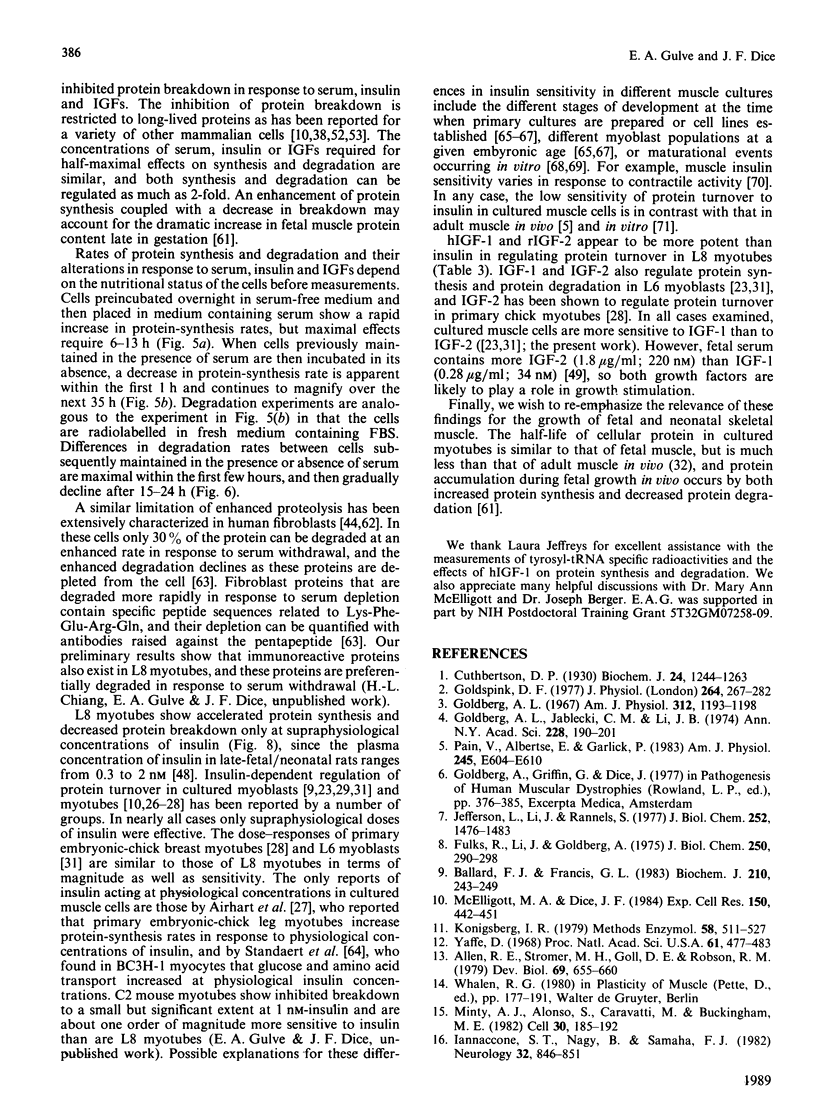

Selected References
These references are in PubMed. This may not be the complete list of references from this article.
- Airhart J., Arnold J. A., Stirewalt W. S., Low R. B. Insulin stimulation of protein synthesis in cultured skeletal and cardiac muscle cells. Am J Physiol. 1982 Jul;243(1):C81–C86. doi: 10.1152/ajpcell.1982.243.1.C81. [DOI] [PubMed] [Google Scholar]
- Allen R. E., Stromer M. H., Goll D. E., Robson R. M. Accumulation of myosin, actin, tropomyosin, and alpha-actinin in cultured muscles cells. Dev Biol. 1979 Apr;69(2):655–660. doi: 10.1016/0012-1606(79)90318-x. [DOI] [PubMed] [Google Scholar]
- Amenta J. S., Sargus M. J., Brocher S. C. Protein synthesis and degradation in growth regulation in rat embryo fibroblasts: role of fast-turnover and slow-turnover protein. J Cell Physiol. 1980 Oct;105(1):51–61. doi: 10.1002/jcp.1041050108. [DOI] [PubMed] [Google Scholar]
- Auteri J. S., Okada A., Bochaki V., Dice J. F. Regulation of intracellular protein degradation in IMR-90 human diploid fibroblasts. J Cell Physiol. 1983 May;115(2):167–174. doi: 10.1002/jcp.1041150210. [DOI] [PubMed] [Google Scholar]
- Ballard F. J., Francis G. L. Effects of anabolic agents on protein breakdown in L6 myoblasts. Biochem J. 1983 Jan 15;210(1):243–249. doi: 10.1042/bj2100243. [DOI] [PMC free article] [PubMed] [Google Scholar]
- Ballard F. J., Read L. C., Francis G. L., Bagley C. J., Wallace J. C. Binding properties and biological potencies of insulin-like growth factors in L6 myoblasts. Biochem J. 1986 Jan 1;233(1):223–230. doi: 10.1042/bj2330223. [DOI] [PMC free article] [PubMed] [Google Scholar]
- Ballard F. J. Regulation of protein accumulation in cultured cells. Biochem J. 1982 Nov 15;208(2):275–287. doi: 10.1042/bj2080275. [DOI] [PMC free article] [PubMed] [Google Scholar]
- Beguinot F., Kahn C. R., Moses A. C., Smith R. J. The development of insulin receptors and responsiveness is an early marker of differentiation in the muscle cell line L6. Endocrinology. 1986 Jan;118(1):446–455. doi: 10.1210/endo-118-1-446. [DOI] [PubMed] [Google Scholar]
- Berger J. J., Dice J. F. Proteolysis in cultured cells during prolonged serum deprivation and replacement. Am J Physiol. 1986 Nov;251(5 Pt 1):C748–C753. doi: 10.1152/ajpcell.1986.251.5.C748. [DOI] [PubMed] [Google Scholar]
- Bonner P. H., Hauschka S. D. Clonal analysis of vertebrate myogenesis. I. Early developmental events in the chick limb. Dev Biol. 1974 Apr;37(2):317–328. doi: 10.1016/0012-1606(74)90152-3. [DOI] [PubMed] [Google Scholar]
- Caravatti M., Perriard J. C. Turnover of the creatine kinase subunits in chicken myogenic cell cultures and in fibroblasts. Biochem J. 1981 May 15;196(2):377–382. doi: 10.1042/bj1960377. [DOI] [PMC free article] [PubMed] [Google Scholar]
- Chiang H. L., Dice J. F. Peptide sequences that target proteins for enhanced degradation during serum withdrawal. J Biol Chem. 1988 May 15;263(14):6797–6805. [PubMed] [Google Scholar]
- Cuthbertson D. P. The disturbance of metabolism produced by bony and non-bony injury, with notes on certain abnormal conditions of bone. Biochem J. 1930;24(4):1244–1263. doi: 10.1042/bj0241244. [DOI] [PMC free article] [PubMed] [Google Scholar]
- Daughaday W. H., Parker K. A., Borowsky S., Trivedi B., Kapadia M. Measurement of somatomedin-related peptides in fetal, neonatal, and maternal rat serum by insulin-like growth factor (IGF) I radioimmunoassay, IGF-II radioreceptor assay (RRA), and multiplication-stimulating activity RRA after acid-ethanol extraction. Endocrinology. 1982 Feb;110(2):575–581. doi: 10.1210/endo-110-2-575. [DOI] [PubMed] [Google Scholar]
- Eriksson U., Andersson A., Efendić S., Elde R., Hellerström C. Diabetes in pregnancy: effects on the foetal and newborn rat with particular regard to body weight, serum insulin concentration and pancreatic contents of insulin, glucagon and somatostatin. Acta Endocrinol (Copenh) 1980 Jul;94(3):354–364. doi: 10.1530/acta.0.0940354. [DOI] [PubMed] [Google Scholar]
- Ewton D. Z., Falen S. L., Florini J. R. The type II insulin-like growth factor (IGF) receptor has low affinity for IGF-I analogs: pleiotypic actions of IGFs on myoblasts are apparently mediated by the type I receptor. Endocrinology. 1987 Jan;120(1):115–123. doi: 10.1210/endo-120-1-115. [DOI] [PubMed] [Google Scholar]
- Federation of American Societies for Experimental Biology. 69th annual meeting, Anaheim, California, April 21-26, 1985. Abstracts of papers 2721-5496. Fed Proc. 1985 Mar 5;44(4):877–1350. [PubMed] [Google Scholar]
- Fischbach G. D., Cohen S. A., Henkart M. P. Trophic functions of the neuron. I. Development of neural connections. Some observations of trophic interaction between neurons and muscle fibers in cell culture. Ann N Y Acad Sci. 1974 Mar 22;228(0):35–46. doi: 10.1111/j.1749-6632.1974.tb20500.x. [DOI] [PubMed] [Google Scholar]
- Fischbach G. D. Synapse formation between dissociated nerve and muscle cells in low density cell cultures. Dev Biol. 1972 Jun;28(2):407–429. doi: 10.1016/0012-1606(72)90023-1. [DOI] [PubMed] [Google Scholar]
- Florini J. R., Ewton D. Z., Evinger-Hodges M. J., Falen S. L., Lau R. L., Regan J. F., Vertel B. M. Stimulation and inhibition of myoblast differentiation by hormones. In Vitro. 1984 Dec;20(12):942–958. doi: 10.1007/BF02619668. [DOI] [PubMed] [Google Scholar]
- Florini J. R., Ewton D. Z., Falen S. L., Van Wyk J. J. Biphasic concentration dependency of stimulation of myoblast differentiation by somatomedins. Am J Physiol. 1986 May;250(5 Pt 1):C771–C778. doi: 10.1152/ajpcell.1986.250.5.C771. [DOI] [PubMed] [Google Scholar]
- Fulks R. M., Li J. B., Goldberg A. L. Effects of insulin, glucose, and amino acids on protein turnover in rat diaphragm. J Biol Chem. 1975 Jan 10;250(1):290–298. [PubMed] [Google Scholar]
- GUROFF G., UNDENFRIEND S. The uptake of tyrosine by isolated rat diaphragm. J Biol Chem. 1960 Dec;235:3518–3522. [PubMed] [Google Scholar]
- Gluckman P. D., Butler J. H. Parturition-related changes in insulin-like growth factors-I and -II in the perinatal lamb. J Endocrinol. 1983 Nov;99(2):223–232. doi: 10.1677/joe.0.0990223. [DOI] [PubMed] [Google Scholar]
- Goldberg A. L., Jablecki C., Li J. B. Trophic functions of the neuron. 3. Mechanisms of neurotrophic interactions. Effects of use and disuse on amino acid transport and protein turnover in muscle. Ann N Y Acad Sci. 1974 Mar 22;228(0):190–201. doi: 10.1111/j.1749-6632.1974.tb20510.x. [DOI] [PubMed] [Google Scholar]
- Goldberg A. L. Work-induced growth of skeletal muscle in normal and hypophysectomized rats. Am J Physiol. 1967 Nov;213(5):1193–1198. doi: 10.1152/ajplegacy.1967.213.5.1193. [DOI] [PubMed] [Google Scholar]
- Goldspink D. F. The influence of immobilization and stretch on protein turnover of rat skeletal muscle. J Physiol. 1977 Jan;264(1):267–282. doi: 10.1113/jphysiol.1977.sp011667. [DOI] [PMC free article] [PubMed] [Google Scholar]
- Gronostajski R. M., Pardee A. B. Protein degradation in 3T3 cells and tumorigenic transformed 3T3 cells. J Cell Physiol. 1984 Apr;119(1):127–132. doi: 10.1002/jcp.1041190120. [DOI] [PubMed] [Google Scholar]
- Iannaccone S. T., Nagy B., Samaha F. J. Partial biochemical maturation of aneurally cultured human skeletal muscle. Neurology. 1982 Aug;32(8):846–851. doi: 10.1212/wnl.32.8.846. [DOI] [PubMed] [Google Scholar]
- Janeczko R. A., Etlinger J. D. Inhibition of intracellular proteolysis in muscle cultures by multiplication-stimulating activity. Comparison of effects of multiplication-stimulating activity and insulin on proteolysis, protein synthesis, amino acid uptake, and sugar transport. J Biol Chem. 1984 May 25;259(10):6292–6297. [PubMed] [Google Scholar]
- Jefferson L. S., Li J. B., Rannels S. R. Regulation by insulin of amino acid release and protein turnover in the perfused rat hemicorpus. J Biol Chem. 1977 Feb 25;252(4):1476–1483. [PubMed] [Google Scholar]
- Johnson J. D., Wetmore D. L. Protein turnover in heart and diaphragm of rat fetus. Am J Physiol. 1984 Dec;247(6 Pt 1):E781–E785. doi: 10.1152/ajpendo.1984.247.6.E781. [DOI] [PubMed] [Google Scholar]
- Kelly F. J., Lewis S. E., Anderson P., Goldspink D. F. Pre- and postnatal growth and protein turnover in four muscles of the rat. Muscle Nerve. 1984 Mar-Apr;7(3):235–242. doi: 10.1002/mus.880070309. [DOI] [PubMed] [Google Scholar]
- Konigsberg I. R. Skeletal myoblasts in culture. Methods Enzymol. 1979;58:511–527. doi: 10.1016/s0076-6879(79)58166-x. [DOI] [PubMed] [Google Scholar]
- Libby P., Goldberg A. L. Comparison of the control and pathways for degradation of the acetylcholine receptor and average protein in cultured muscle cells. J Cell Physiol. 1981 May;107(2):185–194. doi: 10.1002/jcp.1041070204. [DOI] [PubMed] [Google Scholar]
- Martin A. F., Rabinowitz M., Blough R., Prior G., Zak R. Measurements of half-life of rat cardiac myosin heavy chain with leucyl-tRNA used as precursor pool. J Biol Chem. 1977 May 25;252(10):3422–3429. [PubMed] [Google Scholar]
- Mayorek N., Pinson A., Mayer M. Intracellular proteolysis in rat cardiac and skeletal muscle cells in culture. J Cell Physiol. 1979 Mar;98(3):587–595. doi: 10.1002/jcp.1040980316. [DOI] [PubMed] [Google Scholar]
- McElligott M. A., Dice J. F. Intracellular protein degradation in cultures of dystrophic muscle cells and fibroblasts. Exp Cell Res. 1984 Feb;150(2):442–451. doi: 10.1016/0014-4827(84)90588-3. [DOI] [PubMed] [Google Scholar]
- Miller J. B., Stockdale F. E. Developmental origins of skeletal muscle fibers: clonal analysis of myogenic cell lineages based on expression of fast and slow myosin heavy chains. Proc Natl Acad Sci U S A. 1986 Jun;83(11):3860–3864. doi: 10.1073/pnas.83.11.3860. [DOI] [PMC free article] [PubMed] [Google Scholar]
- Minty A. J., Alonso S., Caravatti M., Buckingham M. E. A fetal skeletal muscle actin mRNA in the mouse and its identity with cardiac actin mRNA. Cell. 1982 Aug;30(1):185–192. doi: 10.1016/0092-8674(82)90024-1. [DOI] [PubMed] [Google Scholar]
- Monier S., Le Cam A., Le Marchand-Brustel Y. Insulin and insulin-like growth factor I. Effects on protein synthesis in isolated muscles from lean and goldthioglucose-obese mice. Diabetes. 1983 May;32(5):392–397. doi: 10.2337/diab.32.5.392. [DOI] [PubMed] [Google Scholar]
- Moses A. C., Nissley S. P., Short P. A., Rechler M. M., White R. M., Knight A. B., Higa O. Z. Increased levels of multiplication-stimulating activity, an insulin-like growth factor, in fetal rat serum. Proc Natl Acad Sci U S A. 1980 Jun;77(6):3649–3653. doi: 10.1073/pnas.77.6.3649. [DOI] [PMC free article] [PubMed] [Google Scholar]
- Moss P. S., Spector D. H., Glass C. A., Strohman R. C. Streptomycin retards the phenotypic maturation of chick myogenic cells. In Vitro. 1984 Jun;20(6):473–478. doi: 10.1007/BF02619620. [DOI] [PubMed] [Google Scholar]
- Nemeth P. M., Solanki L., Lawrence J. C., Jr Control of enzyme activities in individual myotubes cultured without nerve. Am J Physiol. 1985 Sep;249(3 Pt 1):C313–C317. doi: 10.1152/ajpcell.1985.249.3.C313. [DOI] [PubMed] [Google Scholar]
- Odessey R., Khairallah E. A., Goldberg A. L. Origin and possible significance of alanine production by skeletal muscle. J Biol Chem. 1974 Dec 10;249(23):7623–7629. [PubMed] [Google Scholar]
- Osborne C. K., Monaco M. E., Lippman M. E., Kahn C. R. Correlation among insulin binding, degradation, and biological activity in human breast cancer cells in long-term tissue culture. Cancer Res. 1978 Jan;38(1):94–102. [PubMed] [Google Scholar]
- Pain V. M., Albertse E. C., Garlick P. J. Protein metabolism in skeletal muscle, diaphragm, and heart of diabetic rats. Am J Physiol. 1983 Dec;245(6):E604–E610. doi: 10.1152/ajpendo.1983.245.6.E604. [DOI] [PubMed] [Google Scholar]
- Poole B., Wibo M. Protein degradation in cultured cells. The effect of fresh medium, fluoride, and iodoacetate on the digestion of cellular protein of rat fibroblasts. J Biol Chem. 1973 Sep 10;248(17):6221–6226. [PubMed] [Google Scholar]
- Prives J. M., Olden K. Carbohydrate requirement for expression and stability of acetylcholine receptor on the surface of embryonic muscle cells in culture. Proc Natl Acad Sci U S A. 1980 Sep;77(9):5263–5267. doi: 10.1073/pnas.77.9.5263. [DOI] [PMC free article] [PubMed] [Google Scholar]
- Richter E. A., Garetto L. P., Goodman M. N., Ruderman N. B. Muscle glucose metabolism following exercise in the rat: increased sensitivity to insulin. J Clin Invest. 1982 Apr;69(4):785–793. doi: 10.1172/JCI110517. [DOI] [PMC free article] [PubMed] [Google Scholar]
- Rogers S., Wells R., Rechsteiner M. Amino acid sequences common to rapidly degraded proteins: the PEST hypothesis. Science. 1986 Oct 17;234(4774):364–368. doi: 10.1126/science.2876518. [DOI] [PubMed] [Google Scholar]
- Rubinstein N., Chi J., Holtzer H. Coordinated synthesis and degradation of actin and myosin in a variety of myogenic and non-myogenic cells. Exp Cell Res. 1976 Feb;97(2):387–393. doi: 10.1016/0014-4827(76)90630-3. [DOI] [PubMed] [Google Scholar]
- Sandra A., Przybylski R. J. Ontogeny of insulin binding during chick skeletal myogenesis in vitro. Dev Biol. 1979 Feb;68(2):546–556. doi: 10.1016/0012-1606(79)90225-2. [DOI] [PubMed] [Google Scholar]
- Schneible P. A., Airhart J., Low R. B. Differential compartmentation of leucine for oxidation and for protein synthesis in cultured skeletal muscle. J Biol Chem. 1981 May 25;256(10):4888–4894. [PubMed] [Google Scholar]
- Siegelbaum S. A., Trautmann A., Koenig J. Single acetylcholine-activated channel currents in developing muscle cells. Dev Biol. 1984 Aug;104(2):366–379. doi: 10.1016/0012-1606(84)90092-7. [DOI] [PubMed] [Google Scholar]
- Silver G., Etlinger J. D. Regulation of myofibrillar accumulation in chick muscle cultures: evidence for the involvement of calcium and lysosomes in non-uniform turnover of contractile proteins. J Cell Biol. 1985 Dec;101(6):2383–2391. doi: 10.1083/jcb.101.6.2383. [DOI] [PMC free article] [PubMed] [Google Scholar]
- Slot L. A., Lauridsen A. M., Hendil K. B. Intracellular protein degradation in serum-deprived human fibroblasts. Biochem J. 1986 Jul 15;237(2):491–498. doi: 10.1042/bj2370491. [DOI] [PMC free article] [PubMed] [Google Scholar]
- Smith T. J., Dana R., Krichevsky A., Bilezikian J. P., Schonberg M. Inhibition of beta-adrenergic responsiveness in muscle cell cultures by dexamethasone. Endocrinology. 1981 Dec;109(6):2110–2116. doi: 10.1210/endo-109-6-2110. [DOI] [PubMed] [Google Scholar]
- Standaert M. L., Schimmel S. D., Pollet R. J. The development of insulin receptors and responses in the differentiating nonfusing muscle cell line BC3H-1. J Biol Chem. 1984 Feb 25;259(4):2337–2345. [PubMed] [Google Scholar]
- Udenfriend S., Stein S., Böhlen P., Dairman W., Leimgruber W., Weigele M. Fluorescamine: a reagent for assay of amino acids, peptides, proteins, and primary amines in the picomole range. Science. 1972 Nov 24;178(4063):871–872. doi: 10.1126/science.178.4063.871. [DOI] [PubMed] [Google Scholar]
- Van Venrooij W. J., Moonen H., Van Loon-Klaassen L. Source of amino acids used for protein synthesis in HeLa cells. Eur J Biochem. 1974 Dec 16;50(1):297–304. doi: 10.1111/j.1432-1033.1974.tb03898.x. [DOI] [PubMed] [Google Scholar]
- Vandenburgh H., Kaufman S. Protein degradation in embryonic skeletal muscle. Effect of medium, cell type, inhibitors, and passive stretch. J Biol Chem. 1980 Jun 25;255(12):5826–5833. [PubMed] [Google Scholar]
- White N. K., Bonner P. H., Nelson D. R., Hauschka S. D. Clonal analysis of vertebrate myogenesis. IV. Medium-dependent classification of colony-forming cells. Dev Biol. 1975 Jun;44(2):346–361. doi: 10.1016/0012-1606(75)90405-4. [DOI] [PubMed] [Google Scholar]
- Yaffe D. Retention of differentiation potentialities during prolonged cultivation of myogenic cells. Proc Natl Acad Sci U S A. 1968 Oct;61(2):477–483. doi: 10.1073/pnas.61.2.477. [DOI] [PMC free article] [PubMed] [Google Scholar]
- Young R. B., Dombroske O. C. Metabolism of myosin heavy chain in steady-state chick skeletal muscle cultures. Biochem J. 1981 Jan 15;194(1):241–247. doi: 10.1042/bj1940241. [DOI] [PMC free article] [PubMed] [Google Scholar]
- Zani B., Cossu G., Adamo S., Molinaro M. Biosynthetic changes in myosin heavy subunit during myogenesis in culture. Differentiation. 1978 Mar 13;10(2):95–100. doi: 10.1111/j.1432-0436.1978.tb00950.x. [DOI] [PubMed] [Google Scholar]


